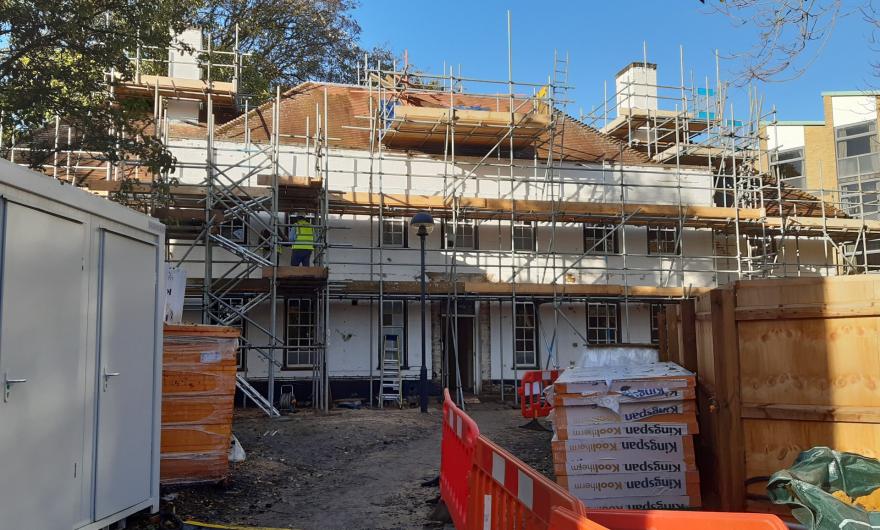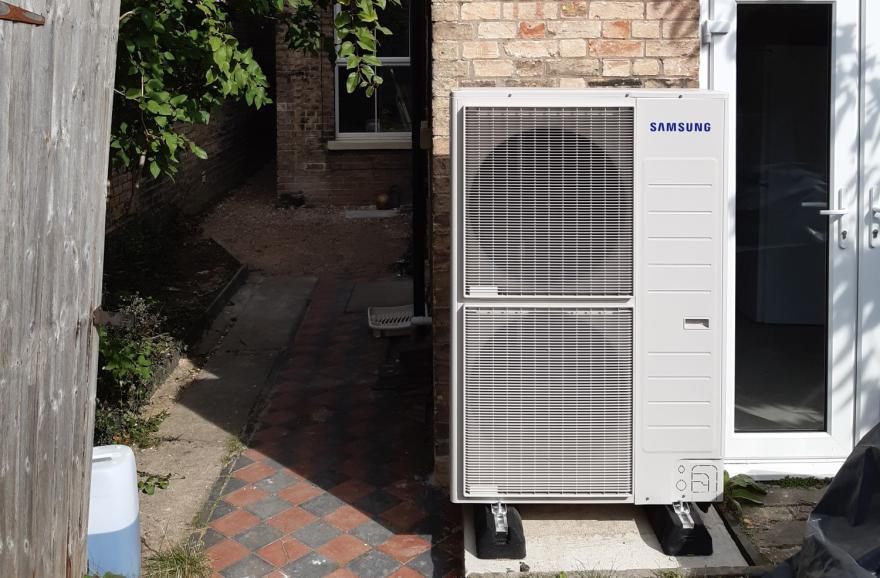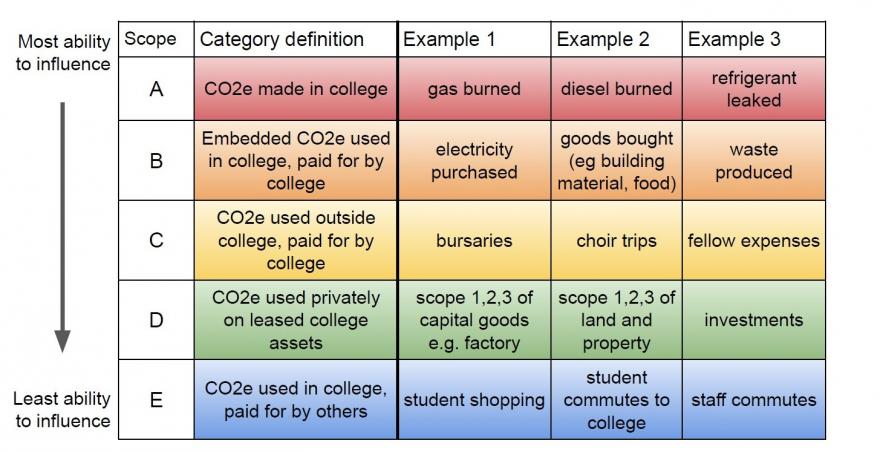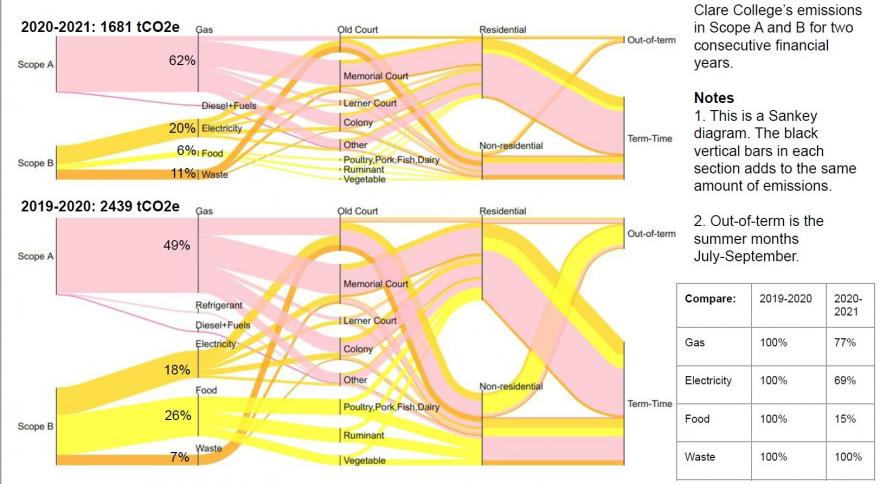Introduction
In order to make the College more sustainable, we have been looking to understand the current position of the College's emissions and what actions might be taken to reduce these.
Clare College has carried out two related detailed studies on the College’s carbon footprint and how to reach Net Zero.
- Firstly, a College sponsored fourth year engineering project to summarise the College’s carbon footprint and make recommendations on how to reduce this.
- Secondly, the commissioning of a specialist consultant to plot a route map to Net Carbon Zero in terms of College Buildings.
Together these two projects give a clear picture of the College’s current emissions and a starting point for reaching Net Zero.
In 2023 the College commissioned a further project to create an implementation plan, with strategies for decarbonising each building.
The College has calculated its Scope 1 and Scope 2 emissions with 2017 used as the baseline year. The footprint is recalculated every year, and from 2019, Scope 3 emissions have started to be included.
Summary of Footprint
The college's reporting year runs from 1 April to 31 March. The baseline year is 2017-18. Scope 3 data has been added for waste from 2019-20, meat from 2022-23, and computer purchases from 2020-21 (first calculated in 2023-24).
The total measured footprint for 2023-24 is 1305 tonnes CO2e (including an offset for purchasing 100% renewable electricity). Scope 1 emissions have reduced by 13% since baseline, and 5% since 2022-23. Scope 1 and 2 emissions have decreased by 44% since baseline.
The College’s total measured emissions have decreased by 30% from the 2017 baseline, despite inclusion of additional items under Scope 3. Offsetting the electricity footprint through purchase of renewable electricity has played a significant part in this reduction. Following decarbonisation projects (notably Braeside), and demand reduction exercises, overall gas consumption was 13% lower in 2023-24 than in 2017-18.

The decrease in the electrical footprint (before being offset) relates to grid decarbonisation. The College is using more electricity overall through the introduction of green technologies.
The increase in gas consumption in 2021 is due to the completion of Clare St Regis, new graduate accommodation, which replaced an older building that was demolished in 2018. The significant change in waste footprint between 2022-23 and 2023-24 reflects new information about how general waste is disposed (now known to be incinerated, rather than assumed to be sent to landfill), rather than a reduction in waste.
The 2023-24 footprint can be seen in more detail on the diagrams below. The pre-offset electricity consumption is included in the breakdown to help assess the overall picture.


Lerner Court Air Source Heat Pumps (Easter 2024)
During the 2024 Easter vacation, the first phase of a project to move Lerner Court (one of the College’s newer buildings) to Air Source Heat Pumps. The project was completed on time, within an extremely tight period to avoid any disruption to students. This initial phase has transferred the heating in student rooms and the hot water system to Air Source Heat Pumps, installed on the roof. At the same time, the College's in house team installed LED lighting to the majority of the student bedrooms. A subsequent phase, to transfer the heating in the conference rooms and decommission the boilers, is due to be carried out next year.
During the first three months of operation (April to June 2024), over 7,500 kg CO2e has been saved.

Braeside Refurbishment (2022-23)
During the academic year 2022-23, a project was carried out at Braeside. This refurbishment project included fully insulating the building to reduce heat loss, and the installation of an Air Source Heat Pump. Additional student rooms were also created, and the existing facilities upgraded. The project was recognised with a Special Award in the 2022-23 Green Impact Awards at the University level.
Sustainability was put at the heart of the Braeside refurbishment project. The most sustainable building is the one that already exists. Buildings are responsible for 39% of global carbon emissions. 28% from operational emissions, from energy needed to heat, cool and power them, and the remaining 11% from materials and construction. Re-using an existing building is the best way of making good use of this embodied carbon. Retrofitting extends a building’s lifespan and provides an excellent opportunity to significantly reduce operational emissions. Braeside had been little changed since it was built in the 1920s. Pre-refurbishment, the building had a heat loss value of 38kW, which equates to an annual footprint of over 17 tonnes of CO2. The sustainability upgrades to the fabric of the building were designed to drastically reduce the heat loss to 12.5kW, that is, by two thirds. To achieve this the retrofit included:
- Upgrades to the building fabric (roof insulation, external wall insulation and window replacement)
- Upgrades to the mechanical and electrical systems (including a new heating and ventilation system
- Installation of an air source heat pump, which, given the College buys all of its electricity on a 100% renewables tariff, reduces the operational carbon footprint of this building to zero.
After the first two terms of operation (Michaelmas 2023 and Lent 2024), over 9,000 kg CO2e has been saved by the project.

69 Alpha Road Air Source Heat Pump (Summer 2022)
This property is a Victorian end terrace house, which provides accommodation for 5 students and had the College’s first air source heat pump installed in Summer 2022. This has now been operational for a full academic year. Together with the improvements to the building fabric, this has made the building net zero in operation (the College purchases 100% renewable electricity). The fabric upgrades and heat pump have meant a 75% reduction in overall energy use, and a £500 saving on utility bills compared with the last academic year.

Carbon Footprint Project 2021-22
The Carbon footprint project included a new system of carbon accounting, which better ranks the College’s emissions based on level of control. The scope system used for the footprint can be seen below.

The use of this revised scope system found c. 33% of emissions not previously accounted for.
College emissions 2019-20 and 2020-21, Joey Bream
Clare College’s emissions are dominated by a small number of sources – gas, electricity, food, and waste production. Together these account for 97% of the College’s footprint in the baseline (19-20) year. Of these, gas use was the single largest contributor to emissions, with the gas used at Memorial Court alone comprising 25% of the total footprint. This makes it clear that reducing gas use, and ultimately removing the College’s reliance on gas for heating and hot water, is crucial for the transition to Net Zero.

Net Zero Route Map 2021-22
The College commissioned a Route Map to Net Zero from Element Energy in 2022. This drew on the carbon footprint project, with a focus on the College’s built estate and how to transition to low carbon heating.
The Route Map highlights the need for ‘fabric first’ improvements, making energy efficiency improvements wherever possible on the College’s estate. There is also a plan to transfer to electric heating, using a mixture of air-, ground-, and river-source systems. Owing to the age, historic importance, and listed nature of the College’s estate, this is a long-term project.
The highlighted interventions from the Route Map have been added into the Colleges 10 year Capital Programme. This includes the electrification of the heating in Memorial Court, the College's single largest source of emissions.

